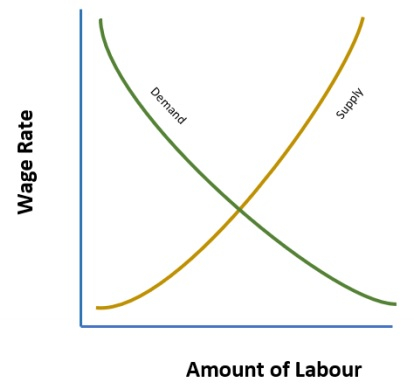
 Data Structure
Data Structure Networking
Networking RDBMS
RDBMS Operating System
Operating System Java
Java MS Excel
MS Excel iOS
iOS HTML
HTML CSS
CSS Android
Android Python
Python C Programming
C Programming C++
C++ C#
C# MongoDB
MongoDB MySQL
MySQL Javascript
Javascript PHP
PHP
- Selected Reading
- UPSC IAS Exams Notes
- Developer's Best Practices
- Questions and Answers
- Effective Resume Writing
- HR Interview Questions
- Computer Glossary
- Who is Who
Labour Market – Definition, Analysis & Microeconomic Example
When we talk about the labour market, we're talking about the supply and demand for labour. Employees offer the supply, and employers provide the demand in this market. It is a critical component of every economy, and it is intimately connected to the markets for capital, commodities, and services, among other things.

Key Points Briefly
It is the supply of and demand for work that is referred to as the labour market, in which employees give the supply and employers provide the demand for labour.
There are two levels of analysis to consider when looking at the labour market: the macroeconomic and the microeconomic.
In the macroeconomic realm, the unemployment rate and labour productivity rates are both significant indicators.
One of the most significant microeconomic indicators is the amount of money earned per hour worked.
Gaining an Understanding of the Labour Market
Individual businesses engage with their workers on a microeconomic level, recruiting and dismissing them, as well as increasing or lowering salaries and working hours. The connection between supply and demand has an impact on the number of hours that workers work as well as the compensation they get in the form of wages, salaries, and benefits.

The Labour Market in the United States
Although capturing the overall perspective of the labour market may be challenging, a few data indicators can provide investors, economists, and policymakers with an indication of the market's health. The first is the state of unemployment. During economic hardship, the demand for labour outstrips the supply of labour, resulting in an increase in unemployment.
The unemployment rate in the United States was about 4 percent to 5 percent prior to the Great Recession, which saw thousands of companies fail, thousands of individuals lose their homes, and the demand for products and services—as well as the labour required to create them—plummet. Unemployment peaked at 10% in 2009, but has been declining more or less consistently since then, reaching 3.5 percent in February 2020.
Using Microeconomic Theory to Explain the Labour Market
To explain this theory using microeconomic example we can one again use the case of wages to understand the principle better. Individuals are always keen to work on higher compensation and an hourly pay of $25 rather than $5. However, the employer must be aware that at first the employees are keen to work at this pay but slowly their interest diminishes.
The other scenario is of executive managers who already enjoy a hefty compensation from the corporation. For such employees, the difference in pay could be marginal. For example, if an employee is already earning $750 per hour and gets the offer to earn $850 with additional responsibilities.
There are more chances that such an employee would opt for that time and would want to spend that time with his family or leisure activities instead of additional work.

